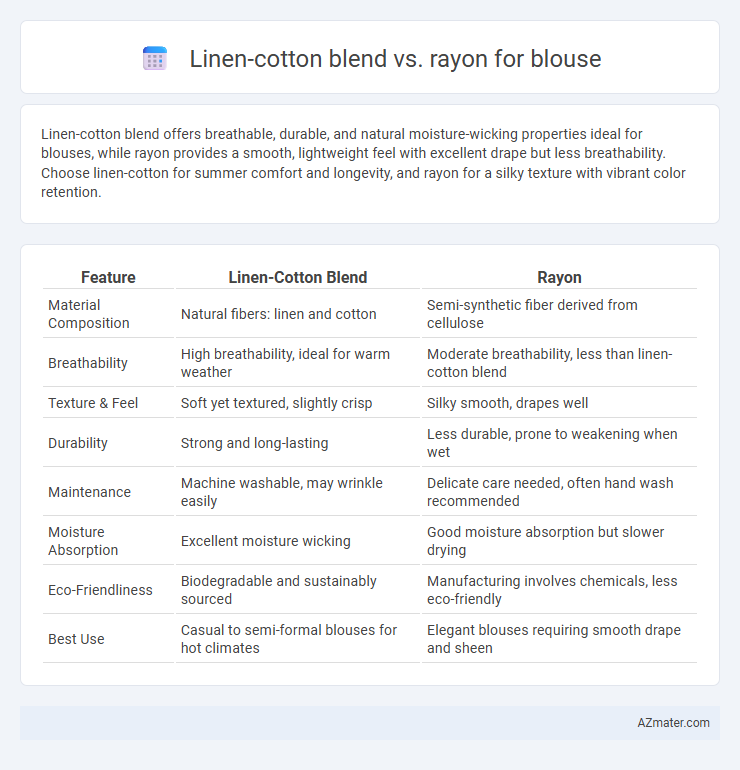Linen-cotton blend offers breathable, durable, and natural moisture-wicking properties ideal for blouses, while rayon provides a smooth, lightweight feel with excellent drape but less breathability. Choose linen-cotton for summer comfort and longevity, and rayon for a silky texture with vibrant color retention.
Table of Comparison
| Feature | Linen-Cotton Blend | Rayon |
|---|---|---|
| Material Composition | Natural fibers: linen and cotton | Semi-synthetic fiber derived from cellulose |
| Breathability | High breathability, ideal for warm weather | Moderate breathability, less than linen-cotton blend |
| Texture & Feel | Soft yet textured, slightly crisp | Silky smooth, drapes well |
| Durability | Strong and long-lasting | Less durable, prone to weakening when wet |
| Maintenance | Machine washable, may wrinkle easily | Delicate care needed, often hand wash recommended |
| Moisture Absorption | Excellent moisture wicking | Good moisture absorption but slower drying |
| Eco-Friendliness | Biodegradable and sustainably sourced | Manufacturing involves chemicals, less eco-friendly |
| Best Use | Casual to semi-formal blouses for hot climates | Elegant blouses requiring smooth drape and sheen |
Introduction: Choosing the Right Fabric for Blouses
Linen-cotton blends offer breathability, durability, and a natural texture ideal for blouses that balance comfort and elegance. Rayon provides a silky smooth feel and excellent drape, enhancing the blouse's softness and flow while maintaining lightweight properties. Selecting between these fabrics depends on the desired blend of texture, moisture-wicking ability, and ease of care for everyday wear or formal occasions.
Linen-Cotton Blend: Key Characteristics
Linen-cotton blend fabric combines the breathability and texture of linen with the softness and durability of cotton, making it ideal for blouses that require both comfort and structure. This blend offers excellent moisture-wicking properties, natural wrinkle resistance, and enhanced durability compared to pure linen. Its hypoallergenic and eco-friendly nature appeals to consumers seeking sustainable, comfortable, and stylish blouse materials.
Rayon Fabric: Essential Properties
Rayon fabric, known for its excellent breathability and smooth texture, offers a lightweight and comfortable feel ideal for blouses in warm weather. Its high moisture absorbency makes rayon a preferred choice for maintaining coolness and softness against the skin. Unlike linen-cotton blends, rayon drapes elegantly and resists wrinkling, enhancing both comfort and style for daily wear.
Comfort and Breathability Comparison
Linen-cotton blend fabric offers superior breathability and moisture-wicking properties, making it highly comfortable for blouses in warm weather due to its natural fibers. Rayon, while soft and smooth, tends to retain heat and lacks the same level of air circulation, potentially causing discomfort during extended wear in hot conditions. The combination of linen and cotton ensures durability and a crisp texture, enhancing overall comfort compared to the synthetic feel of rayon.
Durability and Longevity
Linen-cotton blend fabric offers superior durability and longevity due to its natural fiber strength and resistance to wear and tear, making it ideal for blouses intended for frequent use. Rayon, while soft and breathable, tends to be less durable and may degrade faster with repeated washing and exposure to moisture. Choosing a linen-cotton blend ensures a blouse maintains its structure and appearance over time, providing a longer-lasting wardrobe staple.
Maintenance and Care Requirements
Linen-cotton blends require gentle washing in cold water to prevent shrinkage and maintain fabric integrity, with ironing recommended on medium heat while damp to reduce wrinkles. Rayon demands more delicate care, including hand washing or dry cleaning, as it is prone to shrinking, stretching, and color fading when exposed to water and heat. Both fabrics benefit from air drying to preserve shape and longevity, but rayon's higher sensitivity necessitates stricter maintenance to ensure blouse durability.
Style and Drape: Visual Appeal
Linen-cotton blend blouses offer a natural, textured look with a matte finish that enhances a casual yet refined style, ideal for breathable and structured silhouettes. Rayon blouses provide a smoother, silk-like drape with a subtle sheen, creating an elegant and fluid appearance that flatters more formal or dressy outfits. The choice between linen-cotton and rayon significantly impacts the visual appeal, with linen-cotton emphasizing crisp, defined lines and rayon delivering soft, graceful movement.
Sustainability and Eco-Friendliness
Linen-cotton blends offer superior sustainability due to their natural, biodegradable fibers sourced from flax plants and cotton crops, which require less water and fewer pesticides compared to conventional fabrics. Rayon, while often derived from wood pulp, involves chemical-intensive processing that can lead to significant environmental pollution and deforestation concerns. Choosing linen-cotton blend blouses supports eco-friendliness by promoting renewable agriculture and reduced chemical usage, making them a more sustainable alternative to rayon-based garments.
Ideal Uses: When to Choose Linen-Cotton or Rayon
Linen-cotton blend fabrics are ideal for blouses in warm weather due to their breathability, moisture-wicking properties, and natural texture, making them perfect for casual and office wear. Rayon excels in draping and softness, making it the preferred choice for elegant or flowy blouses suitable for formal events and evening wear. Choose linen-cotton blends for durability and a crisp look, while rayon suits styles requiring a smooth finish and fluid movement.
Conclusion: Which Fabric is Best for Your Blouse?
Linen-cotton blend offers superior breathability, durability, and natural texture, making it ideal for casual and summer blouses that require comfort and longevity. Rayon provides a smooth, silky feel with excellent drape, perfect for elegant and form-fitting blouses but demands more delicate care. Choosing the best fabric depends on your need for breathability and ease of maintenance versus softness and sophistication in appearance.

Infographic: Linen-cotton blend vs Rayon for Blouse
 azmater.com
azmater.com